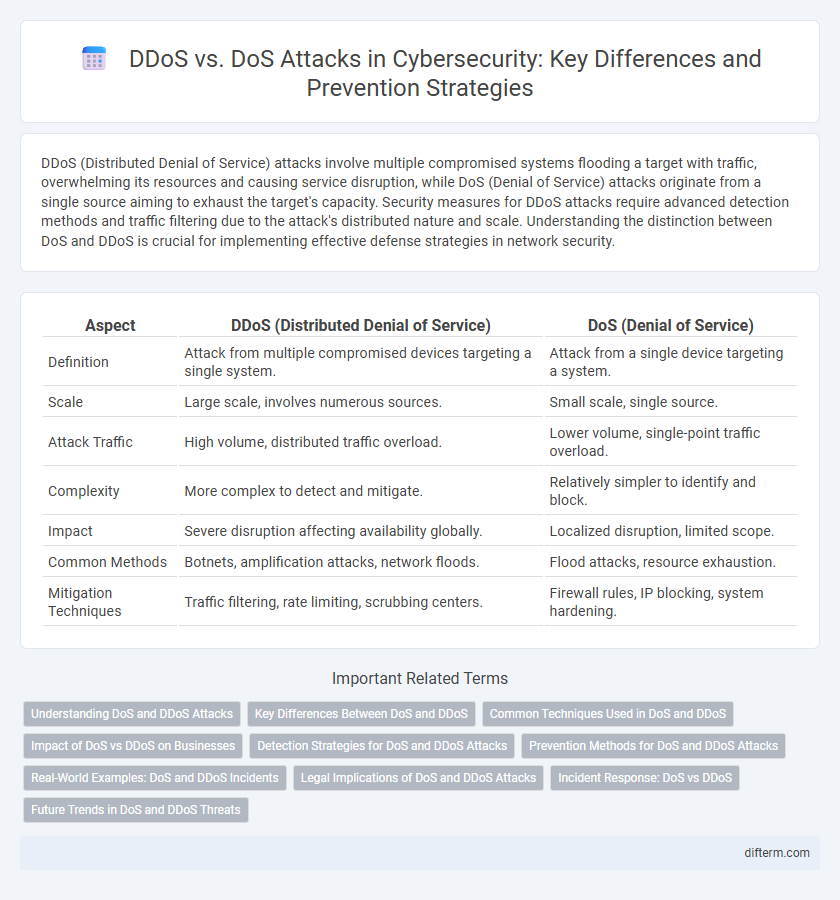DDoS (Distributed Denial of Service) attacks involve multiple compromised systems flooding a target with traffic, overwhelming its resources and causing service disruption, while DoS (Denial of Service) attacks originate from a single source aiming to exhaust the target's capacity. Security measures for DDoS attacks require advanced detection methods and traffic filtering due to the attack's distributed nature and scale. Understanding the distinction between DoS and DDoS is crucial for implementing effective defense strategies in network security.
Table of Comparison
| Aspect | DDoS (Distributed Denial of Service) | DoS (Denial of Service) |
|---|---|---|
| Definition | Attack from multiple compromised devices targeting a single system. | Attack from a single device targeting a system. |
| Scale | Large scale, involves numerous sources. | Small scale, single source. |
| Attack Traffic | High volume, distributed traffic overload. | Lower volume, single-point traffic overload. |
| Complexity | More complex to detect and mitigate. | Relatively simpler to identify and block. |
| Impact | Severe disruption affecting availability globally. | Localized disruption, limited scope. |
| Common Methods | Botnets, amplification attacks, network floods. | Flood attacks, resource exhaustion. |
| Mitigation Techniques | Traffic filtering, rate limiting, scrubbing centers. | Firewall rules, IP blocking, system hardening. |
Understanding DoS and DDoS Attacks
DoS (Denial of Service) attacks disrupt a single target system by overwhelming its resources, causing service unavailability. DDoS (Distributed Denial of Service) attacks use multiple compromised devices, increasing volume and complexity to bypass traditional security defenses. Understanding these attacks is crucial for implementing effective mitigation strategies in network security.
Key Differences Between DoS and DDoS
DoS (Denial of Service) attacks originate from a single source, overwhelming a target system to disrupt its normal functionality, whereas DDoS (Distributed Denial of Service) attacks use multiple compromised devices, known as botnets, to generate a massive volume of traffic, making mitigation more complex. DoS attacks typically impact smaller networks with limited resources, while DDoS attacks can target large-scale infrastructure, including cloud services and enterprise networks, causing widespread disruption. The detection and response to DDoS attacks demand advanced load-balancing and traffic filtering techniques due to their distributed nature and high magnitude.
Common Techniques Used in DoS and DDoS
DoS attacks commonly use techniques such as SYN flood, Ping of Death, and UDP flood to overwhelm a single target's resources, causing service disruption. DDoS attacks amplify this impact by leveraging multiple compromised systems, employing methods like botnets, HTTP floods, and DNS amplification to generate massive traffic. Both attack types exploit network protocol vulnerabilities and consume bandwidth, making mitigation strategies essential for maintaining network security and availability.
Impact of DoS vs DDoS on Businesses
DDoS attacks overwhelm business networks with traffic from multiple sources, causing widespread service outages and significant financial losses that can exceed millions due to downtime and reputational damage. DoS attacks, though originating from a single source, still disrupt critical online services, leading to decreased customer trust and operational delays. Both attack types compromise business continuity, but DDoS attacks typically result in larger-scale impacts because of their volume and complexity.
Detection Strategies for DoS and DDoS Attacks
Detection strategies for DoS and DDoS attacks rely heavily on traffic anomaly analysis, leveraging machine learning algorithms to identify unusual spikes and patterns indicative of malicious activity. Network behavior monitoring tools and intrusion detection systems (IDS) play critical roles in real-time detection by correlating metrics such as packet rates, source IP distribution, and protocol anomalies. Effective detection combines signature-based methods with heuristic approaches to quickly differentiate between legitimate traffic surges and attack vectors, ensuring timely mitigation of both DoS and DDoS threats.
Prevention Methods for DoS and DDoS Attacks
Effective prevention methods for DoS and DDoS attacks include implementing robust firewall rules to filter malicious traffic and deploying intrusion detection and prevention systems (IDPS) to monitor network anomalies. Utilizing rate limiting and traffic filtering techniques helps control the volume of incoming requests, mitigating the risk of service overload. Cloud-based DDoS mitigation services offer scalable protection by absorbing and dispersing attack traffic before it reaches the target infrastructure.
Real-World Examples: DoS and DDoS Incidents
The 2016 Dyn cyberattack exemplifies a large-scale DDoS incident that disrupted major websites like Twitter and Netflix by flooding servers with traffic from a botnet of IoT devices. In contrast, the 2013 Spamhaus attack represents a significant DoS event targeting a single organization's infrastructure through overwhelming traffic on limited network resources. Both incidents highlight the critical need for robust network defenses to mitigate service outages from volumetric and application-layer attacks.
Legal Implications of DoS and DDoS Attacks
DoS and DDoS attacks are illegal under laws such as the Computer Fraud and Abuse Act (CFAA) in the United States, exposing perpetrators to severe criminal charges including fines and imprisonment. These attacks disrupt service availability, causing financial losses and operational damage, which can lead to civil lawsuits for damages from affected organizations. Internationally, various countries have implemented cybercrime statutes targeting DoS and DDoS activities, reflecting the global legal consensus on prosecuting such malicious interference with digital infrastructure.
Incident Response: DoS vs DDoS
Incident response to DoS attacks typically involves isolating the affected system to stop the single-source traffic from overwhelming resources, with quick identification of the attacking IP address facilitating mitigation. In contrast, DDoS incident response requires coordinated efforts across multiple network layers to filter diverse traffic sources, utilizing advanced traffic analysis and rate limiting to prevent service disruption. Effective response to both attack types hinges on real-time monitoring, automated alerting systems, and scalable infrastructure to restore normal operations swiftly.
Future Trends in DoS and DDoS Threats
Evolving attack strategies in DoS and DDoS threats increasingly leverage AI-driven automation and IoT botnets, significantly amplifying the scale and complexity of assaults on network infrastructures. Future trends indicate a rise in multi-vector attacks combining volumetric, protocol, and application-layer methodologies, challenging traditional mitigation techniques. Enhanced behavioral analytics and machine learning-based detection are becoming essential to preemptively identify and neutralize sophisticated DoS and DDoS threats.
DDoS vs DoS Infographic

 difterm.com
difterm.com